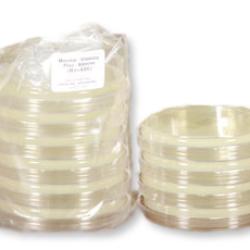Source Institutions
Source Institutions
Add to list Go to activity
Activity link broken? See if it's at the internet archive

In this laboratory experiment, learners explore how effectively different sunscreens protect yeast cells from damage caused by ultraviolet (UV) radiation. Learners may compare differing SPFs of the same brand of sunscreen or different brands with the same SPF. The experiment utilizes a strain of yeast that lacks several DNA repair mechanisms; UV-induced mutations lead to cell death. The experiment provides data for learners to make relative comparisons between sunscreens.
- 1 to 2 hours
- 1 to 2 hours
- Over $20 per group of students
- Ages 8 - adult
- Activity, Experiment/Lab Activity, Lesson/Lesson Plan
- English
Quick Guide
Materials List (per group of students)
- UV-sensitive yeast strain
- YED (Yeast-Extract Dextrose) media plates
- Sterile container with lid
- Sterile pipet to measure 1 ml
- Pipet bulb or pipet pump to use with the pipet, if needed
- Sterile test tubes with caps (optional)
- Sterile distilled water
- 70% or 95% ethyl or isopropyl (rubbing) alcohol
- Waterproof marking pens with fine tips
- Sterile, flat toothpicks
- Aluminum foil
- Paper towels
- Self-sealing (Zip-lock) plastic bag
- Transparent (scotch) tape
- Small brown paper bags (optional)
- Sunscreens of different SPFs and/or different brands
- Other sun protection items such as lip gloss, lenses from sun glasses and fabric
- 2-inch squares of dark paper such as construction paper
- Source of UV radiation - sun, quartz halogen or fluorescent light
- Sun protection - UV-protective glasses, hats, sunscreen, etc. (needed if using the sun as your UV radiation source)
- Place to incubate the yeast (30 degrees C incubator or room temperature)
Subjects
-
Earth and Space Science
-
Solar System
- The Sun
-
Solar System
-
Engineering and Technology
-
Technology
- Medical Technology
-
Technology
-
Life Sciences
-
Cells
- Cell Structure and Function
- Cell Division
-
Diversity of Life
- Protists and Fungi
-
Heredity and Genetics
- DNA Structure and Function
-
Human Body
- Muscles and Skin
- Health and Nutrition
-
Cells
-
Physical Sciences
- Chemistry
-
Vibration and Waves
- Light and Optics
-
Light and Optics
- Sunlight and Color
-
Mathematics
-
Data Analysis and Probability
- Data Analysis
- Data Collection
- Data Representation
-
Data Analysis and Probability
-
The Nature of Science
-
The Scientific Process
- Conducting Investigations
- Gathering Data
- Formulating Explanations
- Communicating Results
-
The Scientific Process
-
The Nature of Technology
-
Technology and Society
- Impacts of Technology
-
Technology and Society
Informal Categories
- Outdoor Activity
Audience
To use this activity, learners need to:
- see
- see color
- read
- touch
Learning styles supported:
- Uses STEM to solve real-world problems
- Involves hands-on or lab activities
Other
Components that are part of this resource:
Includes alignment to state and/or national standards:
Includes assesments for student learning:
This resource is part of:
Access Rights:
- Free access
By:
- Genetic Science Learning Center
Source Collection
- Teach.Genetics
Rights:
- All rights reserved, University of Utah, 2002
Funding Source:
- Howard Hughes Medical Institute Precollege Science Education Initiative for Biomedical Research Institutions Award, 51000125
